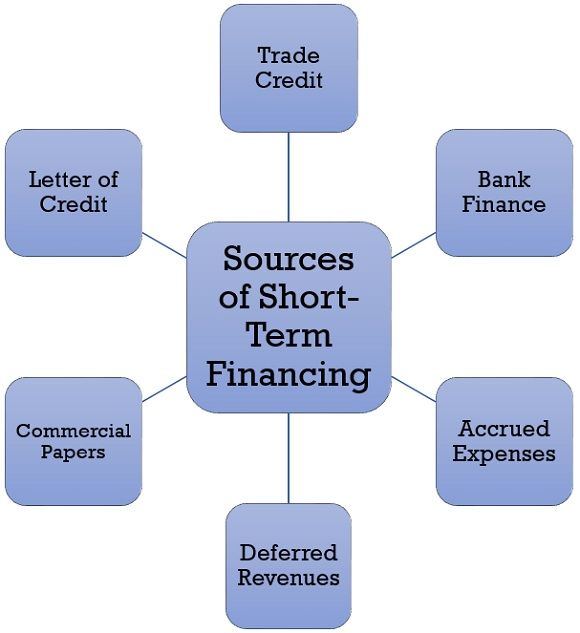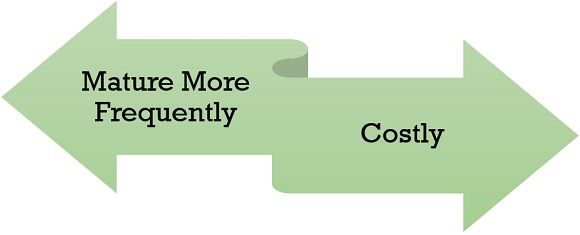Definition: Short-Term Financing is a need for money for a short period of time, i.e., less than a year. It is one of the primary function of finance that manages the demand and supply of capital for an interim period, and these funds can be secured or unsecured. To use such funds total financing funds should be driven by the company, and the company gets directed by the risk-return trade-off for this decision.
The reason behind choosing short-term financing instead of long-term financing is its flexibility, cost and advantages although it has high risk than long-term financing.
Content: Short-Term Financing
Sources of Short-Term Financing
The following are the sources of the Short-Term Financing which the formers refer to in the ordinary course of business:

1. Trade Credit
Trade Credit is also known as accounts payable; it is a credit drawn out by one seller to another when a credit purchase has been made, it helps in supplying goods without immediate payment of cash. It provides a floating time of 28 days to manage the cash flow of the business. Thus, it is widely used by business firms as a source of short-term finance, the amount of trade credit relies upon the purchase units for which credit is available.
- Example: If a company purchases a product of ₹ 1000 per day @ 30, the amount of credit purchase will be 1000*30=30000. However, the nature of such credits differs from company to company. One set of it does not carry a bill enforcing a transaction which is commonly known as open account, in this set the supplier after checking the creditworthiness of the purchases extends credit.
Although it may be risky for the supplier if the buyer does not pay the sum in due course, and to avoid such losses the other set of trade credit is required in which instruments such as promissory notes, bills of exchange are needed. So that in case the supplier needs money, he can discount such bills from the banks. The bills of purchase having a high credit rating can be sold. These instruments minimize the risk of bad debts.
2. Bank Finance
Corporate sector is very much dependent on the commercial bank for fulfilling their short-term financial needs, a limited portion of this need gets fulfilled by the trade credit, and the excess requirement over it gets fulfilled by a commercial bank. Bank credit has two forms, i.e., unsecured and secured credit. Unsecured credits are those that are not covered by collateral securities, and collateral securities cover secured Credits.
Here loan can be provided with either for a specific purpose known as a single loan for which the company signs a promissory note to avoid deficiencies and repays this loan within a specific period of time. On the contrary, the other way of granting a loan is a line of credit which is more common; the bank fixes a limit for the borrower to avoid the cumbersome process of going through essential formalities every time the borrower reaches a bank for a loan.
The ways of borrowing a sum from the bank are as follows:
- Working capital loan
- Discounting of bill
- Overdraft
- Letter of credit
- Cash credit
3. Accrued Expenses
The expenses which have already been acknowledged in the books before it has been paid are known as accrued expenses.
4. Deferred Revenues
Deferred revenue refers to a part of the firm’s income that has not been acquired, but pre-payment has already received by the customers.
5. Commercial Papers
Issuing of commercial papers is also one of the most used sources of financing now-a-days. These are the short-term notes describing that if a company needs money, they can issue commercial papers. It is used for financing of Trade credits, payroll and meeting additional short-term liabilities and commercial paper ranges from 15 days to 1 year.
6. Letter of Credit
The Letter of Credit shows the pledge of the buyer to the seller for making the payment. This document is issued by the bank, safeguarding the prompt and full payment to the seller. If the buyer fails to do so, the bank becomes liable to pay the amount to the seller, for issuing a letter of credit bank charges a percentage of the amount from the buyer and is delivered against the pledge of securities.
Advantages of Short-Term Financing
The advantages to the firm that short-term funds provide are as follows:

- Easy to Obtain: Creditors make short-term funds easier to obtain as the risk involved in delivering loan varies according to payment time, and they think long-term credits or loans contains high-risk factor than short-term loans.
- Less Risky: In Comparison with long-term financing, short-term financing is less risky, as creditors grant credit for a short period of time.
- Resilience: Short-term financing provides resilience as the borrower may adopt alternative sources of credit after negotiating the short-term credit account by debtors.
Disadvantages of Short-Term Financing
The following are the disadvantages of short-term financing:

- Mature More Frequently: Firm’s producing capital goods worries more often about short-term creditors as they produce slow-moving inventories, and short-term financing creates a tight position for a firm more often. If short-term liabilities do not get settled timely, the creditors may demand closure of the firm.
- Costly: When general economic outlooks and collateral elements are considered, short-term finances at times looks costlier than long-term finances.
Conclusion
Short-Term Financing is a way of meeting the financial requirements of the companies for a short period, i.e., 15 days to 1 year. These finances are generally used for making daily expenses, purchasing material and paying tax liabilities arising out of the process of conversion.
Pelumi says
Helpful
Melbourne says
Lenders are often more flexible than traditional lenders when it comes to loan terms and eligibility criteria.